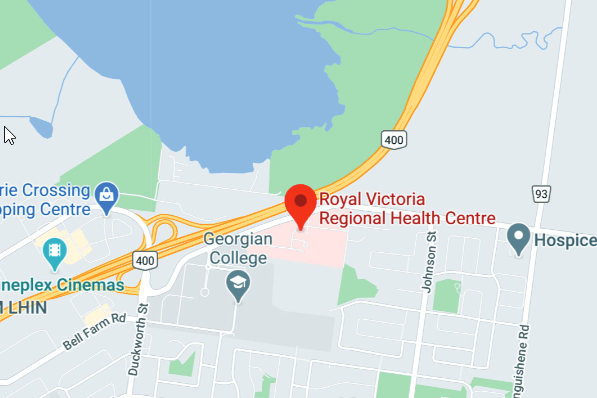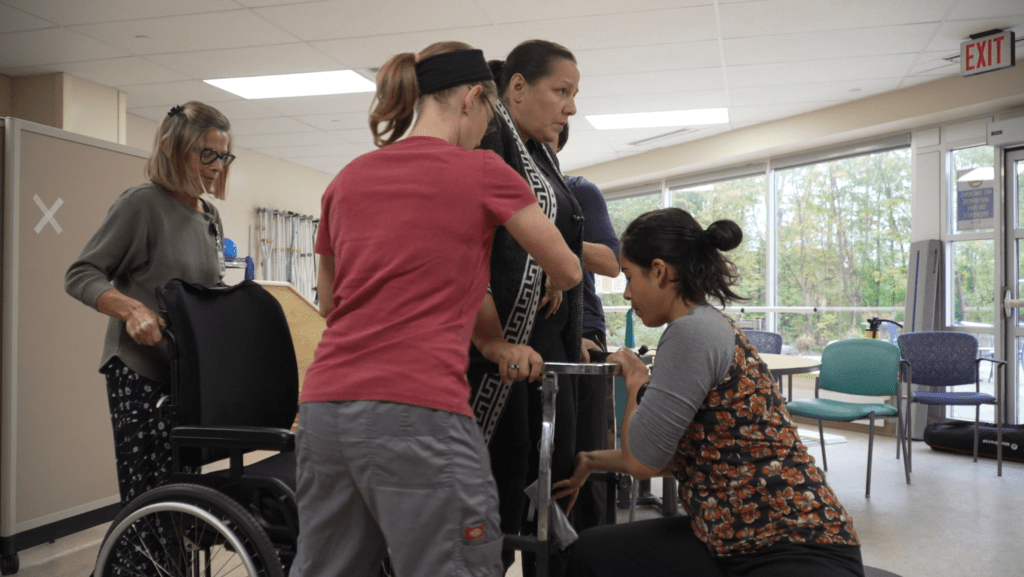The RVH stroke program is home to the Enhanced District Stroke Centre which includes RVH clinical stroke services and regional planning responsibilities (Central East Stroke Network). RVH provides best practice interprofessional stroke care in the emergency department, Integrated Stroke and Rehabilitation Unit, Stroke Prevention Clinic, and Rehabilitation Day Program.
RVH is dedicated to providing the best possible experience for those who are at risk for having a stroke and for those who require care and rehabilitation after a stroke. Eligible patients from across Simcoe County are transported to RVH for assessment and consideration of hyperacute stroke therapies. The goal of these therapies is to improve patient recovery by dissolving and/or removing the clot in the brain. A special medical team must screen and assess patients for these therapies, to determine if they are eligible.
Thrombolytic therapy is used to dissolve the clot. It uses the drug tPA, which must be given at RVH within 4.5 hours from when the stroke symptoms started. Patients who are eligible and receive tPA will be transferred back to their home hospital after 24-48 hours of monitoring. Some of these patients may also be considered potential candidates for Endovascular therapy (EVT).
Endovascular therapy (EVT) is a procedure used to remove a blood clot in the brain. Patients that present within 24 hours of stroke symptom onset will be assessed for whether they may benefit from EVT. Patients who are potential candidates will be transferred to an Endovascular Stroke Centre in Toronto. Patients that are transferred and receive EVT will typically be admitted, then when ready, will be transferred to a stroke unit closer to home. Stroke units in Simcoe County are located at RVH and Orillia Soldiers Memorial Hospital.
Patients who are determined not eligible for tPA or EVT will be transferred to their home hospital directly from the RVH Emergency Department.
- Provide patient and family centered care that reflects the RVH MY CARE strategic plan
- Provide care that reflects the Canadian Best Practice Recommendations for Stroke Care
- Value roles and perspectives of patients and families in the recovery journey
- Provide compassionate and hopeful care and instill trust for patients and families
- Work together with patients and families and think big to maximize recovery and optimize quality of life following stroke
- Provide leadership and collaborate with our community partners to advance stroke care within the Central East Stroke Region (Simcoe, Muskoka, York, Durham, Haliburton, Kawartha, and Pine Ridge geography which is included within the North Simcoe Muskoka, Central and Central East Local Health Integration Networks)
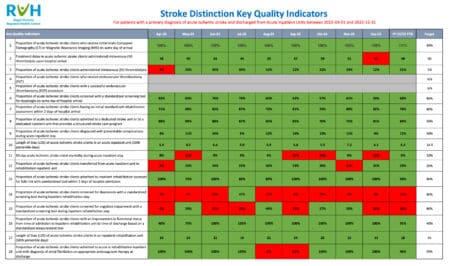
RVH provides cross continuum stroke services through hyperacute, acute and rehabilitation
(inpatient and out-patient) and stroke prevention services. Across these settings, the overarching goals of the stroke program are to:
- Provide best practice stroke care that is supported by clinical pathways, validated assessments and comprehensive care planning that reflects the Canadian Best Practice Recommendations for Stroke Care
- Conduct timely interprofessional assessment of all patients admitted using validated assessment tools
- To own our clinical practice and ensure stroke care expertise within the interprofessional team through annual maintenance of stroke care competencies
- Work together with families and caregivers to address individualized education and information needs;
- Work together with our community partners to achieve smooth transitions across the stroke care continuum, ensuring quality and timely care in the right setting
Our goals are to:
- Provide timely access to appropriate assessment, screening and diagnostic testing that meets Canadian Best Practice Recommendations for Stroke
- Provide thrombolysis (tPA) to eligible patients as soon as possible after hospital arrival, with a target time of within 30 minutes of arrival to RVH Emergency Department
- Refer appropriate patients for stroke endovascular therapy and transfer to the EVT centre within 45 minutes of arrival to the RVH Emergency Department.
- Refer all non-admitted patients with Transient Ischemic Attack/Nondisabling stroke to the RVH Stroke Prevention Clinic
Our goals are:
- Complete nursing admission assessments, Falls Risk and Pressure Ulcer Risk assessments within 24 hours
- Complete interprofessional team assessments on all patients with stroke within 48 hours of admission using validated assessment tools
- Minimize complications of stroke through the use of evidence-based care pathways, validated screening tools and comprehensive care planning
- Initiate referral to vascular surgery for consideration of carotid endarterectomy
- Complete the Alpha Functional Independence Measure (AlphaFIM®) on all patients on day 3 of admission to support triage to the most appropriate care setting within the recommended time frames
- Access stroke prevention services for medical optimization, education, self-management and healthy lifestyle support, risk factor management
Our goals are to:
- Work together with patients and their families
- Provide best practice interprofessional rehabilitation, tailored to individual needs and functional goals;
- Empower patients and families to be active partners in the rehabilitation journey and goal setting process;
- Facilitate seamless transitions through comprehensive discharge planning that includes patients and their families, and community partners
- Ensure effective communication and linkages between the Integrated Stroke Unit, the Rehabilitation Day Program and the North Simcoe Muskoka Home and Community Care Program
Our goals are to:
- Provide patient and families with information about Home and Community Care Support Services – North Simcoe Muskoka, community rehabilitation and other community resources, facilitate linkages and initiate referrals
- Offer eligible patients timely access to hospital based outpatient inter-professional stroke rehabilitation through the Rehabilitation Day Program
- Work together with community partners to facilitate ongoing self-management, health promotion and successful community reintegration and lifelong recovery for patients and their families
- Think big and work together with our community partners to address current gaps in stroke care within Simcoe County, Ontario Health Central & East Regions, and throughout the Central East Stroke Region
- Provide early access to multidisciplinary assessment, diagnostic testing, treatment, and referral for patients who have been identified at high risk for stroke
- Provide education on lifestyle and vascular risk management, stroke prevention and warning signs for stroke
- Facilitate linkages to community programs including community exercise programs and cardiovascular rehabilitation for secondary prevention and chronic disease management
Admission criteria for Rehabilitation requirements:
- Be 18 years of age or older
- Have a diagnosis of stroke, or amputation requiring prosthetic training. Patients with neurodegenerative disease as their admitting diagnosis are not eligible for admission.
- Be referred to the program by a Primary Care Provider. The referral must be complete and may be returned if additional information is required
- Be medically stable and activity tolerance supports active participation in outpatient therapy
- Have experienced the neurological event for which he or she is referred within the past 3 months and/or be a new prosthetic limb user
- Require the services of one or more of the following: Occupational Therapy, Physiotherapy, Speech Language Pathology, Registered Nursing, Social Work
- Reside within and/or between the areas of Barrie, Innisfil, Collingwood, Wasaga Beach, Midland, and parts of Alliston
- Not be receiving inpatient hospital care
- Not be a resident of a long term care facility
- Able to transfer between level surfaces with moderate assistance of two people (Note: persons requiring the use of a mechanical lift are not eligible)
- Demonstrate rehabilitation potential and have functional goals that are attainable in a 12 – 14 week period
- Have supports and products to manage bladder and bowel incontinence (if applicable)
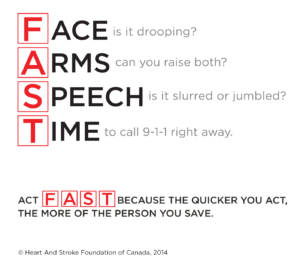
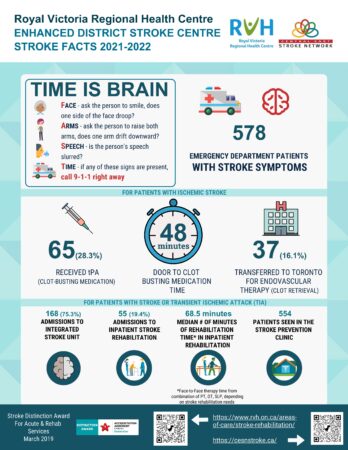
Post-Stroke Checklist
North Simcoe Muskoka Self-Management Programs
The Living with Stroke Program
Stroke Recovery Barrie
North Simcoe Muskoka Health line
Stroke Engine Family
Heart and Stroke
RVH Virtual & On Line Patient, Family, Caregiver, Stroke Resources
RVH Community Resources and Self-Management Information
RVH Stroke Prevention Clinic Patient Education
Integrated Stroke Unit and Rehabilitation Inpatients
This 40 bed unit cares for the acute care needs of patients that have had a stroke, and as soon as they are ready and appropriate for rehabilitation, move them right into the intensive rehabilitation program. We provide best practice stroke care and follow evidence-based clinical pathways.
The unit is also designed to help patients achieve their individualized goals. We use evidence-based screening tools, techniques, and equipment to develop each patients’ needs and functional goals.
Our healthcare team consists of physicians, registered nurses, registered practical nurses, patient care assistants, dietitians, pharmacists, physiotherapists, occupational therapists, a discharge planner, social worker, a respiratory therapist, a speech language pathologist, a chaplain, unit clerks, and volunteers. Each member has a specific role to play to ensure seamless integration of care and together, they strive to provide exceptional care to each patient and family.
Integrated Stroke and Rehabilitation Inpatient
Phone: 705-728-9090 Ext. 47350
Manager: Lillian Morrison
Phone: 705-728-9090 Ext. 47305
Fax: 705-792-3317
Email: morrisonl@rvh.on.ca
Stroke Prevention Clinic
The Stroke Prevention clinic is for patients who have experienced a Transient Ischemic Attack – “A Mini Stroke” or a mild, non-disabling stroke that does not require hospitalization. The goal of the Stroke Prevention Clinic is to provide early access to multidisciplinary assessment, diagnostic testing, treatment, and referral for patients who have been identified at high risk for stroke. The clinic provides prevention services i.e. diagnostic testing, risk factor assessment and treatment.
Appointments or Booking Office:
705-728-9090 Ext. 23300
Fax Number: 705-728-3039
Manager: Ben McIsaac
Phone: 705-728-9090 Ext. 48240
Email: mcisaacb@rvh.on.ca
The Stroke Prevention Clinic requires a referral.
Your family doctor or the doctor who saw you in the emergency department can send a referral to the clinic. You will be contacted within 2-3 business days of receiving the referral. If you were told you have been referred and have not been contacted, please call the clinic.
Your family doctor or the doctor who saw you in the emergency department will send the clinic copies of any tests that you may have had done.
Arrangements may be made for you to have pre-clinic fasting blood work at the hospital diagnostic centre or another preferred laboratory setting.
You may meet the following Stroke Prevention Clinic staff:
- Stroke Prevention Specialist
- Acute Care Nurse Practitioner
- Registration Clerk
You may be referred to other members of the health care team
Clinic visits may include:
- Neurological assessment
- Medical and surgical history
- Blood pressure
- Height and weight
- Waist circumference
- Review of diagnostic test results
- Risk factor identification
- Patient and family education
- Treatment plan
- Potentially diagnostic tests if ordered by the Stroke Physician that may be conducted and/or booked that day
- Bring your health card
- Take all of your regular medications on the day of your appointment
- Bring all your current medications in their original containers
- Bring a copy of any recent blood-work/test reports (i.e X-rays) if they were done at another Hospital
- Your spouse, family members or a friend are welcome to come with you to your appointment
- Your appointment will take between 30 minutes to 2 hours
- The clinic is wheelchair accessible
Integrated Stroke Unit and Rehabilitation
Phone: 705-728-9090 Ext. 47350
Manager: Lillian Morrison
Phone: 705-728-9090 Ext. 47305
Fax: 705-797-3073
Rehabilitation Day Program
Phone: 705-728-9090 Ext. 47347
Hours of Operation:
Monday-Tuesday: 8:30 a.m. – 4:00 p.m.
Wednesday: 8:30 a.m. – 12:15 p.m.
Friday: 8:30 a.m. – 4:00 p.m.
View Ambulatory Rehabilitation Day Program Referral pdf
Stroke Prevention Clinic
Phone: 705-728-9090 Ext. 23300
Fax: 705-728-3039
Hours of Operation:
Monday and Thursday: 8 a.m. – 4 p.m.
Central East Stroke Network
Donelda Sooley, Regional Director
Phone: 705-728-9090 Ext. 46300
Ambulatory Rehabilitation Day Program Referral Form
Stroke Prevention Clinic Referral Form
Integrated Stroke Unit and Rehabilitation Inpatient
201 Georgian Drive, ON L4N 6M2
From the Main Entrance, follow the Blue Navigation Line to the Atrium (Orange) Elevators. Take the elevators to level 3. From the elevator turn left, Integrated Stroke Unit & Rehabiliation Inpatient is straight ahead.
Rehabilitation Day Program
Location: Register at Treatment Clinic Recurring Check In on Level 1 before going to Rehabilitation Day Program. From Treatment Clinic Recurring Check In turn left following the Blue Navigation line. Rehabilitation Day Program is located at the end of the hallway on your left.
Note: Press the accessibility door button to enter the clinic.
